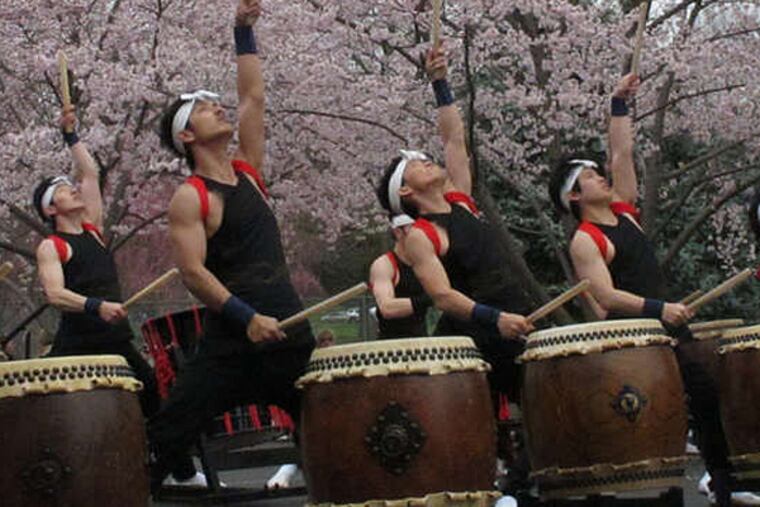So how'd we get those cherry blossoms?
Every spring, Philadelphia's cherry blossom trees begin their elegant, temporal bloom. And every spring, the Japan America Society of Greater Philadelphia hosts the annual Subaru Cherry Blossom Festival, celebrating all aspects of Japanese culture.

Every spring, Philadelphia's cherry blossom trees begin their elegant, temporal bloom. And every spring, the Japan America Society of Greater Philadelphia hosts the annual Subaru Cherry Blossom Festival, celebrating all aspects of Japanese culture.
The festival takes place April 6 to 12, but officially kicks off with Tamagawa Taiko Drum and Dance Troupe performances, starting Saturday at the Painted Bride Art Center.
Many people know about the fest: its observance of ohanami - the picnics beneath the blossoming trees - and events featuring traditional drum ensembles, culinary delights, and decorative celebrations. But how many of the Cherry Blossom Fest's devotees know its history, the ecological impact of the trees, or their ritual symbolism?
After all, thousands of the Japanese trees have been planted throughout the city in the most surprising places, from traffic islands in South Philadelphia to shopping malls in the Greater Northeast, says Aaron Dilliplane, assistant director of the Japan America Society.
In 1926, Japan bestowed 1,600 flowering cherry trees on the city to celebrate the sesquicentennial. It's this original gift that holds the greatest mythic resonance for fans of the fest. "Some of those same trees are still alive today, residing near the sundial at the Horticulture Center" of the Fairmount Park Conservancy, Dilliplane said. "When our society was founded in 1994, part of our historical research . . . was dedicated to that gift of trees for Philadelphia's 150th anniversary of independence."
The 1926 gift from Japan's then-Ministry of Foreign Affairs was meant to symbolize friendship, the return of spring, and Bushido cultural values connected to the trees' natural, but temporal, allure. "That fleeting beauty is what makes them Japan's natural treasure," Dilliplane said of the trees and their three-week window of blooms.
But the trees of 1926 were just the beginning.
From 1998 to 2007, the Japan America Society planted trees throughout Fairmount Park, along both sides of Schuylkill, near the Philadelphia Museum of Art along Kelly and Martin Luther King Drives, and around the Fairmount Park Horticulture Center and Memorial Hall.
The society planted six varieties: early-flowering Prunus 'Okame'; Prunus serrulata 'Kwanzan'; Prunus x subhirtella 'Pendula'; Prunus x yedoensis 'Yoshino'; double-flowering Prunus serrulata 'Shirotae'; and Prunus autumnalis.
In terms of the ecosystem, Lori Hayes, manager of the horticulture center, said the flowers of all cherry trees were the first food and pollen source for honeybees and other pollinators, as the trees bloom earliest in spring. "The trees also provide a structural home for wildlife such as birds and squirrels," she said. "Many have nests clearly visible now."
But there's more to the festival than trees. Philadelphia's Japan America Society holds everything from economic seminars and political forums to informal language classes. The Cherry Blossom Fest is the, well, metaphoric cherry on top.
This year's festival features usual events such as Madame Saito's sushi-making classes, Yokai (the Hour of Meeting Evil Spirits) storytelling sessions, origami demonstrations, tea-ceremony lessons, Kabuki dance jams, kimono dressing, and Shogi & Go game playing. "Everybody looks forward to those traditions," said Dilliplane, "as close to old Japan as you can get without leaving town."
How is this year's Subaru Cherry Blossom Festival different from last year's? Outdoor events will include a 10K run to go with the usual 5K run April 11 around Fairmount Park. That evening, there will be a sushi and sake cocktail party with Denise Nakano of NBC10 for Sakura Under the Stars.
During the Sakura Sunday party, the festival will also mark the maintenance of tradition with just a hint of modernism - some anime cos play, several K-pop bands. "The Sakura party really is our most complete event, our can't-miss feature," said Dilliplane. It's the Japan America Society of Philadelphia's Super Sunday, "where we maintain the delicate balance of everyday fun with the spirit of authenticity."
Taste of Cherry Blossom Festival
For a complete schedule, go to subarucherryblossom.org or call 267-348-0250.
Tamagawa Taiko, the Painted Bride Art Center, 230 Vine St., 4 and 8 p.m. Saturday, $25 advance, $30.
Sushi-making class with Madame Saito, the Headhouse, 122 Lombard St., 6:30 p.m. April 6 and 10, $50 per class.
Origami demonstration, Liberty Place Rotunda, 16th and Chestnut Streets, noon April 7. Free.
Kimono dressing, Liberty Place Rotunda, 16th and Chestnut Streets, noon April 8. Free.
Shogi & Go, Liberty Place Rotunda, 16th and Chestnut Streets, noon April 10. Free.
Sakura Sunday, Fairmount Park Horticulture Center, 100 N. Horticulture Dr., 9:30 a.m.-5 p.m. April 12. Cost: $10; children under 12 free.
Yokai: The Hour of Meeting Evil Spirits, Camden County Library, M. Allan Vogelson Regional Branch, Room A,
203 Laurel Rd., Voorhees, 7 p.m. April 16. Free.EndText